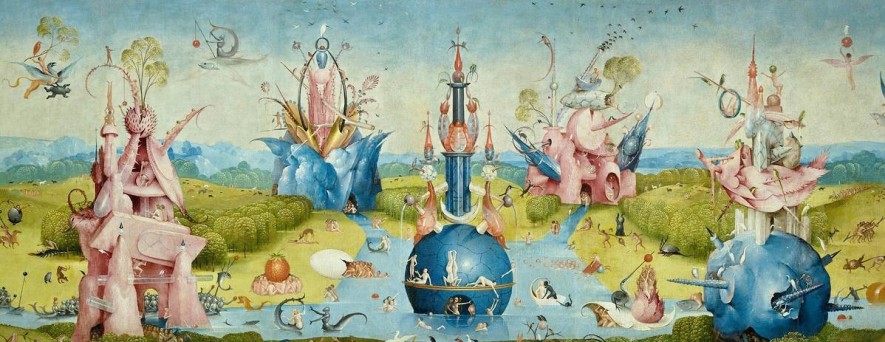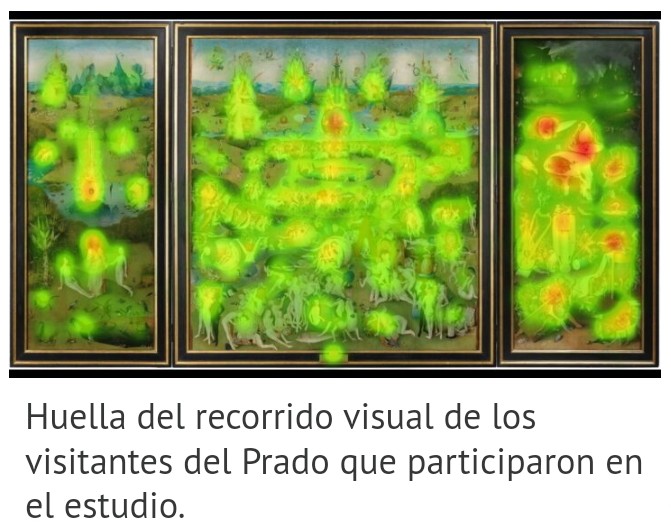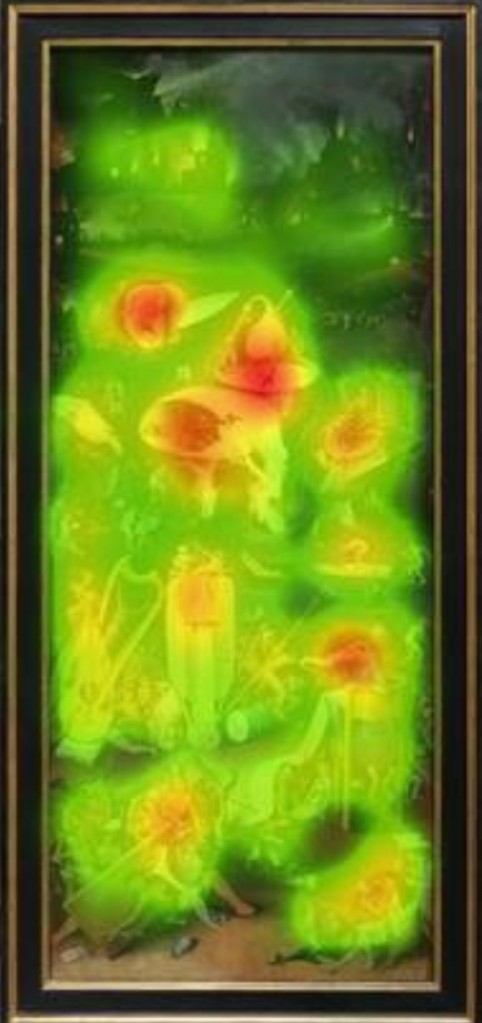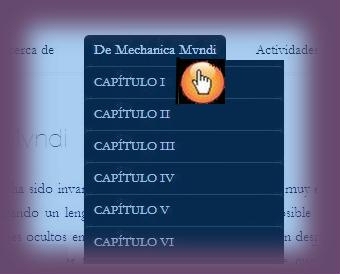Estudian atención de los visitantes al observar al Bosco.





Estudian atención de los visitantes al observar al Bosco.
Luis Sánchez Pena
(Intro a DMM, traducción: Amara Pérez Davila)
«En cada regreso al Prado, El Bosco me parece un pintor todavía más realista. Las zonas de escrupulosa observación son mucho más frecuentes que las de delirio. Lo fantástico no resulta de la ruptura con lo visible, sino de la mezcla chocante de algunos de sus elementos literales, o simplemente de una inversión en las proporciones. Lo común se vuelve monstruoso al aumentar de tamaño.»
http://cultura.elpais.com/cultura/2016/09/09/babelia/1473420077_712899.html
http://xn--antoniomuozmolina-nxb.es/2016/09/el-bosco-en-el-retiro/
———————————————————
DMM. Una lectura escatocosmológica de El Jardín de las Delicias de Hieronymus Bosch.

 El Noordbrabants Museum rinde homenaje a Jerónimo Bosch (El Bosco) con una gran exposición retrospectiva en Bolduque, Holanda Los préstamos han sido posibles gracias al proyecto de investigación más extenso que nunca se ha hecho sobre El Bosco Bolduque Holanda, 29 de octubre de 2015 – El Noordbrabants Museum de Bolduque presenta del 13 de febrero al 8 de mayo de 2016 una exposición dedicada a Jerónimo Bosch “El Bosco”. Esta gran exposición retrospectiva sobre Jerónimo Bosch (h. 1450, Bolduque 1516) se basa en la investigación internacional más exhaustiva jamás realizada sobre la obra, relativamente reducida, del Bosco. Nunca antes se habían podido reunir tantas obras del Bosco bajo una misma exposición, y esto ha sido posible en su ciudad natal, Bolduque, el lugar donde fueron concebidas. Restauraciones: 12 pinturas que pueden verse por primera vez en Bolduque Para preparar la exposición en Bolduque, se han restaurado un gran número de cuadros, tras el Proyecto de Investigación y Conservación del Bosco (Bosch Research and Conservation Project, BRCP), que incluye –entre otros- fondos de la Fundación Getty. Estas 12 pinturas se volverán a mostrar restauradas por primera vez al público durante esta exposición. La presentación dará una nueva y sorprendente imagen de la rica obra de Jerónimo Bosch. Importantes obras de todo el mundo en Bolduque Las decenas de préstamos proceden de importantes museos de todo el mundo, entre los que se encuentran El carro de heno, del Museo Nacional del Prado (Madrid), La nave de los locos del Musée du Louvre (París), 4 obras de las Visiones del más allá de la Gallerie dell’Accademia/Palazzo Grimani (Venecia), y otras obras maestras procedentes de, entre otros, el Museum Boijmans Van Beuningen (Rotterdam), y el Metropolitan Museum (Nueva York). El excepcional número de obras en préstamo de esta exposición ofrece a los visitantes una oportunidad única de estudiar en profundidad el revolucionario e imaginativo lenguaje visual de Jerónimo Bosch. La base de la exposición: el Bosch Research and Conservation Project Los preparativos para la exposición en el Noordbrabants Museum dieron inicio en 2007. La base para los préstamos excepcionales llevados a cabo para esta exposición se estableció con el Bosch Research and Conservation Project (BRCP), una ambiciosa investigación internacional histórico-artística a gran escala fundada en colaboración con la Fundación Jheronimus Bosch 500 y la Radboud Universiteit de Nimega. Durante los últimos seis años, un equipo de expertos internacionales, bajo la dirección de Jos Koldewij y Matthijs Ilsink, han estudiado y documentado de manera intensiva y sistemática, utilizando las técnicas más innovadoras, prácticamente toda la obra del maestro El Bosco. Esto ha resultado en una colaboración entre todos los museos que tienen en su colección pinturas y dibujos del Bosco, lo que ha hecho posible la organización de esta exposición. Los resultados del Bosch Research and Conservation Project, largamente esperados, forman el punto de partida de la exposición que se mostrará en 2016. Los resultados de este estudio científico se publicarán en un monográfico de dos volúmenes sobre Jerónimo Bosch que se compone de un catálogo de obras y estudios técnicos, con un total de cerca de 1.000 páginas. Además de este catálogo de obras, también se ha creado un catálogo público y una página web muy avanzada, pero a la vez fácil de utilizar, en la que puede consultarse toda la documentación del BRCP. 1516-2016: Celebración de los 500 años de la muerte del Bosco En 2016 se cumplen exactamente los 500 años de la muerte de Jerónimo Bosch en Bolduque. La exposición es el punto culminante del evento Jheronimus Bosch 500, que se celebra en 2016 con motivo del quinto centenario de la muerte del artista, y que supone un homenaje sin precedentes al artista medieval más importante de Holanda. La mayor parte de sus obras regresa a Bolduque (‘sHertogenbosch), la ciudad que le vio nacer con el nombre de Jheronimus van Aken, en la que pintó sus obras maestras, y a la que debe su nombre artístico: El Bosco. La exposición constará de unas 20 pinturas y 19 dibujos de la mano del maestro El Bosco, de las cuales 4 serán trípticos y 4 serán paneles pintados en ambas caras. Además, se mostrarán 7 paneles realizados en su taller o por importantes imitadores. Finalmente, se mostrarán 70 obras pertenecientes al contexto de este arte de los siglos XV y XVI. Esta será la primera presentación al público de 12 pinturas especialmente restauradas para el año del Bosco, entre las que se encuentran 3 trípticos. Jerónimo Bosch es el artista medieval más importante y original de nuestro país. Es una ambición largamente perseguida que en 2016 la gran mayoría de su obra pueda regresar a Bolduque, su ciudad de nacimiento. También es maravilloso que las nuevas generaciones puedan conocer estas obras únicas en todos los sentidos. Charles de Mooij, director del Noordbrabants Museum Jerónimo Bosch: El pintor medieval más importante de Holanda Distintivo de El Bosco son los famosos monstruos, figuras diabólicas, ángeles y santos que habitan sus dibujos y paneles. Su característica obra, repleta de ilusiones y alucinaciones, asombrosas monstruosidades y pesadillas, representa de forma inimitable los grandes temas de su tiempo: la seducción, el pecado y la expiación. Los cuadros y pinturas del Bosco, realizadas en el periodo alrededor de 1500, en plena transición entre la Edad Media y el Renacimiento, reflejan de manera enigmática la relación entre el ser humano, su entorno y su creador. Jerónimo Bosch fue un artista genial cuya obra mostraba mundos que sus contemporáneos no creían posibles. Se trata de un artista cuya obra tuvo muchos imitadores en las generaciones que le siguieron, y que todavía hoy sigue inspirando a nuevos artistas. Disposición temática de la exposición La exposición se ha dispuesto de manera amplia y espaciosa, y está dispuesta por temas. El visitante es guiado por la exposición según los siguientes temas: El peregrinaje de la vida, El Bosco en Bolduque, La vida de Cristo, El Bosco como dibujante, Los santos y El fin de los tiempos. Utilizando las técnicas empleadas durante el estudio científico, las reconstrucciones y visualizaciones incorporadas a la exposición dan una perspectiva nunca antes vista sobre la creación de las obras del Bosco. Celebraciones del Año del Bosco en Holanda Bolduque y el resto de Holanda celebran en 2016 el regreso de las obras del famoso pintor Jerónimo Bosch a su ciudad natal. Los visitantes serán bienvenidos a esta gran manifestación cultural que contendrá un rico y variado programa para todo aquel que sienta interés por el pintor medieval, su mundo y su obra. El punto culminante de esta manifestación será la exposición que tendrá lugar en el Noordbrabants Museum. Pero la obra del Bosco inspirará además multitud de eventos tales como extraordinarias producciones de música, danza, teatro y circo, proyectos en espacios públicos, espectáculos de luz, etc. Consulte el programa completo en: http://www.bosch500.nl . Bolduque: uno de los centros medievales más antiguos de Holanda ’s-Hertogenbosch es el nombre oficial de la ciudad. En el lenguaje común se utiliza casi siempre Den Bosch. Este nombre significa “el bosque del duque” (de ahí la traducción en español “Bolduque”). En 1185, el Duque Hendrik I de Brabante otorgó a la ciudad los derechos y privilegios mercantiles correspondientes. El lugar más antiguo del corazón de Bolduque es la plaza de Markt, donde vivió el residente más famoso de la ciudad: El Bosco. El centro es el área fortificada más grande de Holanda. Dentro de las murallas de la ciudad, Bolduque ha conservado en gran medida su estructura medieval con sus múltiples calles serpenteantes y escalonadas con almacenes y viviendas de comerciantes junto al río Dieze. Jerónimo Bosch podría orientarse hoy en su ciudad sin problemas. Además de una visita a la exposición, los aficionados a la obra del Bosco pueden visitar el centro histórico, con una subida a la catedral en estilo gótico tardío de San Juan, una visita a la plaza Markt con la estatua de Jerónimo, el Ayuntamiento, la casa de ladrillos más antigua de Holanda (De Moriaan), o navegar por el río Dieze, el sistema centenario de canales dentro de las murallas de Bolduque. Además, merece la pena visitar el centro didáctico Jheronimus Bosch Art Center para una mayor profundización en la materia. Bolduque, capital de la provincia de Brabante Septentrional, ha sido además declarada en cuatro ocasiones la ciudad más acogedora de Holanda. Agradecimientos La exposición forma parte de la manifestación cultural Jheronimus Bosch 500 y es posible gracias, entre otros, al Ayuntamiento de ’s-Hertogenbosch, la Provincia de Noord-Brabant, Ministerio de Educación, Cultura y Ciencia, BankGiro Loterij, Essent, Rabobank, Gieskes-Strijbis Fonds, Fonds 21, Ammodo, Fondo de Cultura Prins Bernhard, KLM y The Getty Foundation. Venta de entradas en línea: tickets.hnbm.nl (a partir del 1 de diciembre de 2015)
El Noordbrabants Museum rinde homenaje a Jerónimo Bosch (El Bosco) con una gran exposición retrospectiva en Bolduque, Holanda Los préstamos han sido posibles gracias al proyecto de investigación más extenso que nunca se ha hecho sobre El Bosco Bolduque Holanda, 29 de octubre de 2015 – El Noordbrabants Museum de Bolduque presenta del 13 de febrero al 8 de mayo de 2016 una exposición dedicada a Jerónimo Bosch “El Bosco”. Esta gran exposición retrospectiva sobre Jerónimo Bosch (h. 1450, Bolduque 1516) se basa en la investigación internacional más exhaustiva jamás realizada sobre la obra, relativamente reducida, del Bosco. Nunca antes se habían podido reunir tantas obras del Bosco bajo una misma exposición, y esto ha sido posible en su ciudad natal, Bolduque, el lugar donde fueron concebidas. Restauraciones: 12 pinturas que pueden verse por primera vez en Bolduque Para preparar la exposición en Bolduque, se han restaurado un gran número de cuadros, tras el Proyecto de Investigación y Conservación del Bosco (Bosch Research and Conservation Project, BRCP), que incluye –entre otros- fondos de la Fundación Getty. Estas 12 pinturas se volverán a mostrar restauradas por primera vez al público durante esta exposición. La presentación dará una nueva y sorprendente imagen de la rica obra de Jerónimo Bosch. Importantes obras de todo el mundo en Bolduque Las decenas de préstamos proceden de importantes museos de todo el mundo, entre los que se encuentran El carro de heno, del Museo Nacional del Prado (Madrid), La nave de los locos del Musée du Louvre (París), 4 obras de las Visiones del más allá de la Gallerie dell’Accademia/Palazzo Grimani (Venecia), y otras obras maestras procedentes de, entre otros, el Museum Boijmans Van Beuningen (Rotterdam), y el Metropolitan Museum (Nueva York). El excepcional número de obras en préstamo de esta exposición ofrece a los visitantes una oportunidad única de estudiar en profundidad el revolucionario e imaginativo lenguaje visual de Jerónimo Bosch. La base de la exposición: el Bosch Research and Conservation Project Los preparativos para la exposición en el Noordbrabants Museum dieron inicio en 2007. La base para los préstamos excepcionales llevados a cabo para esta exposición se estableció con el Bosch Research and Conservation Project (BRCP), una ambiciosa investigación internacional histórico-artística a gran escala fundada en colaboración con la Fundación Jheronimus Bosch 500 y la Radboud Universiteit de Nimega. Durante los últimos seis años, un equipo de expertos internacionales, bajo la dirección de Jos Koldewij y Matthijs Ilsink, han estudiado y documentado de manera intensiva y sistemática, utilizando las técnicas más innovadoras, prácticamente toda la obra del maestro El Bosco. Esto ha resultado en una colaboración entre todos los museos que tienen en su colección pinturas y dibujos del Bosco, lo que ha hecho posible la organización de esta exposición. Los resultados del Bosch Research and Conservation Project, largamente esperados, forman el punto de partida de la exposición que se mostrará en 2016. Los resultados de este estudio científico se publicarán en un monográfico de dos volúmenes sobre Jerónimo Bosch que se compone de un catálogo de obras y estudios técnicos, con un total de cerca de 1.000 páginas. Además de este catálogo de obras, también se ha creado un catálogo público y una página web muy avanzada, pero a la vez fácil de utilizar, en la que puede consultarse toda la documentación del BRCP. 1516-2016: Celebración de los 500 años de la muerte del Bosco En 2016 se cumplen exactamente los 500 años de la muerte de Jerónimo Bosch en Bolduque. La exposición es el punto culminante del evento Jheronimus Bosch 500, que se celebra en 2016 con motivo del quinto centenario de la muerte del artista, y que supone un homenaje sin precedentes al artista medieval más importante de Holanda. La mayor parte de sus obras regresa a Bolduque (‘sHertogenbosch), la ciudad que le vio nacer con el nombre de Jheronimus van Aken, en la que pintó sus obras maestras, y a la que debe su nombre artístico: El Bosco. La exposición constará de unas 20 pinturas y 19 dibujos de la mano del maestro El Bosco, de las cuales 4 serán trípticos y 4 serán paneles pintados en ambas caras. Además, se mostrarán 7 paneles realizados en su taller o por importantes imitadores. Finalmente, se mostrarán 70 obras pertenecientes al contexto de este arte de los siglos XV y XVI. Esta será la primera presentación al público de 12 pinturas especialmente restauradas para el año del Bosco, entre las que se encuentran 3 trípticos. Jerónimo Bosch es el artista medieval más importante y original de nuestro país. Es una ambición largamente perseguida que en 2016 la gran mayoría de su obra pueda regresar a Bolduque, su ciudad de nacimiento. También es maravilloso que las nuevas generaciones puedan conocer estas obras únicas en todos los sentidos. Charles de Mooij, director del Noordbrabants Museum Jerónimo Bosch: El pintor medieval más importante de Holanda Distintivo de El Bosco son los famosos monstruos, figuras diabólicas, ángeles y santos que habitan sus dibujos y paneles. Su característica obra, repleta de ilusiones y alucinaciones, asombrosas monstruosidades y pesadillas, representa de forma inimitable los grandes temas de su tiempo: la seducción, el pecado y la expiación. Los cuadros y pinturas del Bosco, realizadas en el periodo alrededor de 1500, en plena transición entre la Edad Media y el Renacimiento, reflejan de manera enigmática la relación entre el ser humano, su entorno y su creador. Jerónimo Bosch fue un artista genial cuya obra mostraba mundos que sus contemporáneos no creían posibles. Se trata de un artista cuya obra tuvo muchos imitadores en las generaciones que le siguieron, y que todavía hoy sigue inspirando a nuevos artistas. Disposición temática de la exposición La exposición se ha dispuesto de manera amplia y espaciosa, y está dispuesta por temas. El visitante es guiado por la exposición según los siguientes temas: El peregrinaje de la vida, El Bosco en Bolduque, La vida de Cristo, El Bosco como dibujante, Los santos y El fin de los tiempos. Utilizando las técnicas empleadas durante el estudio científico, las reconstrucciones y visualizaciones incorporadas a la exposición dan una perspectiva nunca antes vista sobre la creación de las obras del Bosco. Celebraciones del Año del Bosco en Holanda Bolduque y el resto de Holanda celebran en 2016 el regreso de las obras del famoso pintor Jerónimo Bosch a su ciudad natal. Los visitantes serán bienvenidos a esta gran manifestación cultural que contendrá un rico y variado programa para todo aquel que sienta interés por el pintor medieval, su mundo y su obra. El punto culminante de esta manifestación será la exposición que tendrá lugar en el Noordbrabants Museum. Pero la obra del Bosco inspirará además multitud de eventos tales como extraordinarias producciones de música, danza, teatro y circo, proyectos en espacios públicos, espectáculos de luz, etc. Consulte el programa completo en: http://www.bosch500.nl . Bolduque: uno de los centros medievales más antiguos de Holanda ’s-Hertogenbosch es el nombre oficial de la ciudad. En el lenguaje común se utiliza casi siempre Den Bosch. Este nombre significa “el bosque del duque” (de ahí la traducción en español “Bolduque”). En 1185, el Duque Hendrik I de Brabante otorgó a la ciudad los derechos y privilegios mercantiles correspondientes. El lugar más antiguo del corazón de Bolduque es la plaza de Markt, donde vivió el residente más famoso de la ciudad: El Bosco. El centro es el área fortificada más grande de Holanda. Dentro de las murallas de la ciudad, Bolduque ha conservado en gran medida su estructura medieval con sus múltiples calles serpenteantes y escalonadas con almacenes y viviendas de comerciantes junto al río Dieze. Jerónimo Bosch podría orientarse hoy en su ciudad sin problemas. Además de una visita a la exposición, los aficionados a la obra del Bosco pueden visitar el centro histórico, con una subida a la catedral en estilo gótico tardío de San Juan, una visita a la plaza Markt con la estatua de Jerónimo, el Ayuntamiento, la casa de ladrillos más antigua de Holanda (De Moriaan), o navegar por el río Dieze, el sistema centenario de canales dentro de las murallas de Bolduque. Además, merece la pena visitar el centro didáctico Jheronimus Bosch Art Center para una mayor profundización en la materia. Bolduque, capital de la provincia de Brabante Septentrional, ha sido además declarada en cuatro ocasiones la ciudad más acogedora de Holanda. Agradecimientos La exposición forma parte de la manifestación cultural Jheronimus Bosch 500 y es posible gracias, entre otros, al Ayuntamiento de ’s-Hertogenbosch, la Provincia de Noord-Brabant, Ministerio de Educación, Cultura y Ciencia, BankGiro Loterij, Essent, Rabobank, Gieskes-Strijbis Fonds, Fonds 21, Ammodo, Fondo de Cultura Prins Bernhard, KLM y The Getty Foundation. Venta de entradas en línea: tickets.hnbm.nl (a partir del 1 de diciembre de 2015)
NOTA PARA LA REDACCIÓN — Si tiene cualquier pregunta o desea obtener material gráfico de la exposición, puede ponerse en contacto con: Het Noordbrabants Museum, departamento de Comunicación y Marketing Neeltje van Gool, Tel: +31 (0)73-6877 815 o pers@HNBM.nl http://www.hnbm.nl • Twitter @NoordbrabantsM • Facebook.com/NoordbrabantsMuseum